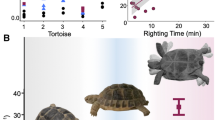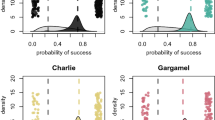Abstract
THE spectacular hereditary trait of backward somersaulting by Tumbler pigeons has been known since 1600 AD1 and was described by Darwin as “… one of the most remarkable inherited habits or instincts ever recorded …”2. The potentially important physiological mechanism of tumbling is unknown, largely because the extreme rapidity of the somersaulting blurs visual observation of the component motions3–9. Filming at 2,000 frames per second the normal flight of Racing Homer pigeons and characteristic tumbling episodes by Parlor (non-flying) Tumbler pigeons, we observed the following. The body position of a pigeon just before and during tumbling is associated with abnormal dorsiflexion of the tail, which occurs within 15 ms after the pigeon is released. Tumbling is synchronised with apparently normal wing movements, propelling the pigeon in only a backward direction, at a rate of 8–10 somersaults per second.
This is a preview of subscription content, access via your institution
Access options
Subscribe to this journal
Receive 51 print issues and online access
$199.00 per year
only $3.90 per issue
Buy this article
- Purchase on Springer Link
- Instant access to full article PDF
Prices may be subject to local taxes which are calculated during checkout
Similar content being viewed by others
References
Levi, W. M., Encyclopedia of Pigeon Breeds (T.F.H. Publications, Jersey City, New Jersey, 1965).
Darwin, C., Animals and Plants under Domestication (Appleton, New York, 1897).
Mowrer, O. H., J. comp. Psychol., 30, 515 (1940).
Gilbert, R. E., thesis, Univ. Utah (1947).
Lange, D. D., thesis, Drake Univ. (1952).
Entrikin, R. K., thesis, Univ. Cincinnati (1971).
Entrikin, R. K., and Erway, L. C., J. Hered. . 63, 351 (1972).
Entrikin, R. K., and Bryant, S. H., Fedn Proc., 32, 374 (1973).
Entrikin, R. K., and Bryant, S. H., J. Neurobiol. (in the press).
Author information
Authors and Affiliations
Rights and permissions
About this article
Cite this article
ENTRIKIN, R., BRYANT, S. Tumbling in pigeons. Nature 252, 706–708 (1974). https://doi.org/10.1038/252706a0
Received:
Revised:
Issue Date:
DOI: https://doi.org/10.1038/252706a0
This article is cited by
-
Touching base
Nature Genetics (2005)
Comments
By submitting a comment you agree to abide by our Terms and Community Guidelines. If you find something abusive or that does not comply with our terms or guidelines please flag it as inappropriate.



